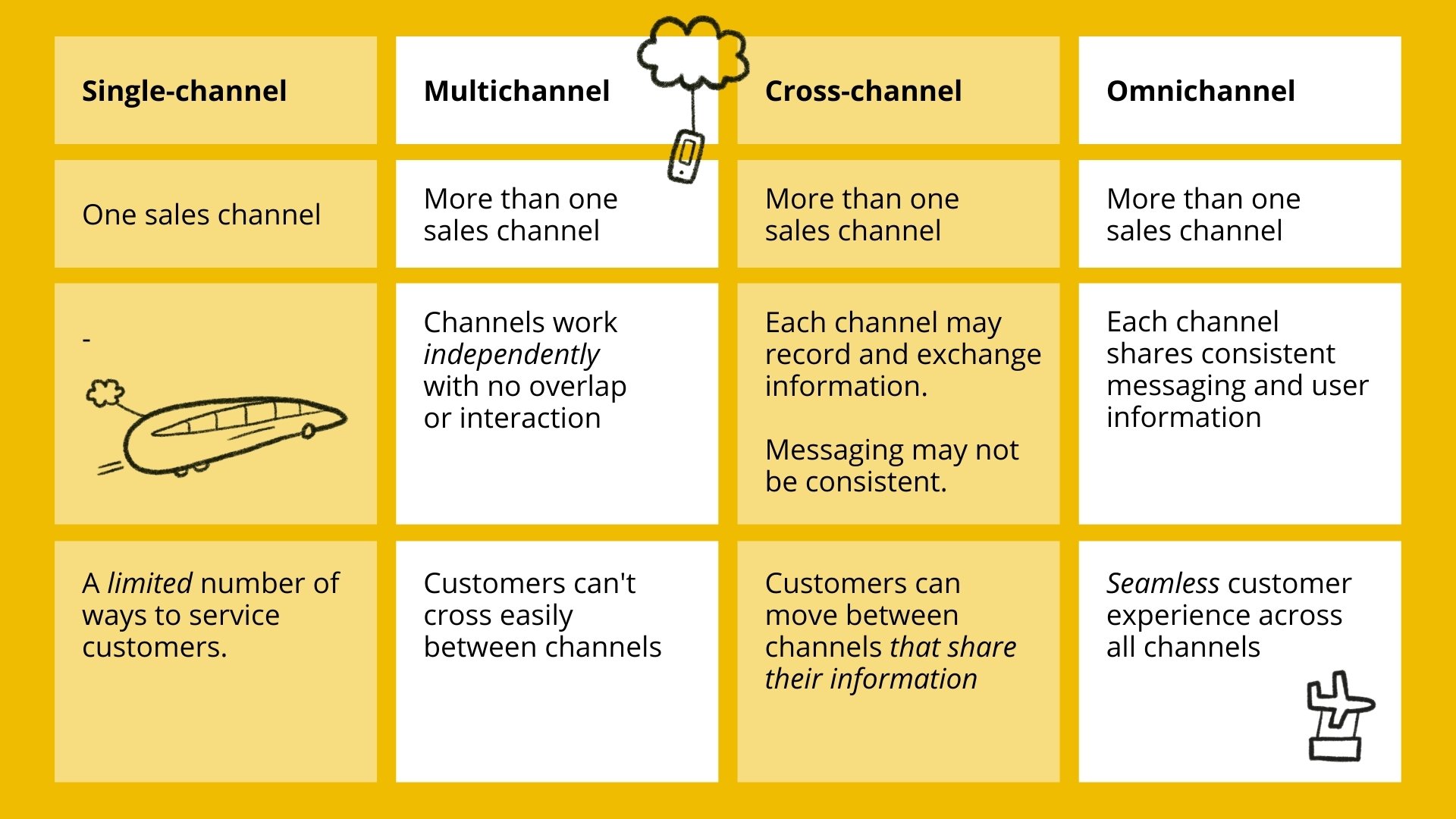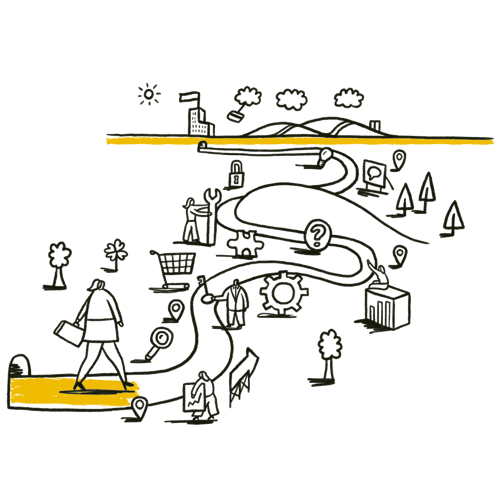The past year has seen a marked migration of B2B (business-to-business) transactions from face-to-face to online—and this decisive shift has challenged many of our assumptions about B2B selling.
Up to 80% of B2B decision-makers now prefer digital and remote interactions with representatives. And almost 90% of sales have since moved to a remote sales model, facilitated by videoconferencing, phone or online contact.
But technology is only half the picture.
Changes in online B2B buying behaviour has created a disconnect between customers and sellers. Customer's advanced digital-first expectations now conflict with the traditionally complex B2B buying process of sellers. Two-thirds of all B2B purchasing decisions are now made on digital channels, but not all merchants have adapted to online sales channels.
A solid omnichannel strategy is essential for B2B companies and offers the following benefits: better customer loyalty as customers are served consistently on all channels, higher sales thanks to flexibility in the checkout process and more efficient interactions that speed up the purchasing process. Companies that implement omnichannel concepts have a competitive advantage in the long term.
 Understanding the basics
Understanding the basics
Commerce has evolved, starting from single-channel marketing and expanding to multichannel, cross-channel, and finally omnichannel.
The shift from single-channel to omnichannel is the logical outcome of increasing digital adoption in the B2B space. Companies have gradually adapted to more remote and self-serve sales models, following their customers' lead, and accelerated the process through the disruption of the past year and a half. As a result, digitally-enabled B2B omnichannel marketing has become the holy grail for today's B2B companies.
Let's explore the key differences between each type of sales model:
E-commerce has become a defining pillar of the omnichannel mix due to the rise of the "digital buyer" who does their online research and uses digital content to finalise their vendor list. This has been all to the benefit of B2B companies: up to 83% of B2B leaders say omnichannel marketing equals or exceeds traditional methods' ability to prospect and secure new business—a rise of 54% from 2020.

A practical approach to building your omnichannel e-commerce strategy
Modern retail e-commerce companies have set a high bar for omnichannel expertise. That bar is the one that traditional B2B businesses often struggle to overcome. Before 2020, some 60% of leading B2B companies "had either no or limited e-commerce capabilities." Even now, many B2B enterprises are still struggling to catch up.
A McKinsey analysis found that many omnichannel efforts are often hampered by a lack of clarity, with insights obscured by one or more of the following:
- Unclear understanding of what parts of omnichannel to prioritise;
- Focus on tech rather than on customer value; and
- Failure to sequence investments in line with the strategy.
To bridge the gulf between your expectations and the omnichannel approach that delivers what you need, you'll need a considered approach that incorporates the following tips:
Tip 1: Start small and scale-up
Getting to the "omni" in omnichannel shouldn't be hurried; you don't need to change all your business processes in one go. In the long term, your goal with omnichannel commerce should be to merge your processes into one to provide users with a unified experience across all touchpoints.
This can be accomplished using a phased approach, where you start small but implement continuous and iterative changes. As you progress, you measure the impacts of your changes and refine your process.
Recommended read: Intershop e-book on "Minimum Viable Product" approach in e-commerce to help you get started quickly and scale systematically.
Tip 2: Put your sales and customer service staff at the centre stage
While digital solutions play a more significant role in B2B businesses, sales staff should retain the essential role in the customer journey. A McKinsey study found that B2B businesses that "add the human touch to digital sales consistently outperform their peers." Your omnichannel strategy must figure out how digital tools can help sales reps perform at their best--not sideline the latter entirely.
For instance, the role of a contact manager has only increased for construction and maintenance supplies provider Würth Netherlands as the company evolved into a powerful B2B omnichannel shopping platform serving over three million B2B customers.
Even as "digital innovations in recent years made things less personal... [the contact manager] is highly valued," explains Gerard Scheffel, E-Commerce Manager at Würth Netherlands. "This way, we have become a personal point of contact, available 24/7 through all of our sales channels."
Customer contact staff at Würth are trained to operate on multiple sales channels. Their performance is assessed by the capacity to push deals through digital and person-to-person channels alike.
Tip 3: Use quantitative and qualitative research to understand your end-users
Würth's B2B omnichannel approach is based on ongoing research, constantly gauging users' needs in different countries in real-time.
Qualitative and quantitative research allow B2B companies like Würth to transform buyer insights into buyer-centric, solution-specific value propositions that lead to almost immediate conversion. "If, for example, a customer is working with dangerous materials, we will provide him with the necessary safety sheets," explains Scheffel.
 Tip 4: Use your customer's buying journey to map your channels
Tip 4: Use your customer's buying journey to map your channels
Your B2B omnichannel strategy should map your customers' purchase process. By seeing the buying journey from your customer's point of view, you can promptly determine how your different channels line up with customer touchpoints and affect how your customers interact with each one. You can then position your channels depending on where they can best serve your customer.
With your customers' buying journey as a guide, you can plan how each digital and live-contact touchpoint can address their identified customer needs and preferences.
Tip 5: You can't improve what you can't measure.
You'll need to strictly define the processes and metrics of each segment of your omnichannel plan and set KPIs to measure your progress from the very start.
Do you need to measure the increase in sales over time? Conversion rates? Customer satisfaction and loyalty? Ensure your B2B omnichannel platform can track these KPIs through custom tools like customer analytics, survey tools and e-commerce analytics.
Each step in the B2B customer journey should constantly gather accurate, meaningful data; measure the data against relevant KPIs, and use the resulting insights to improve the processes continuously.
Tip 6: Use data to create personalised experiences
Whether your B2B company sells just a handful of niche products, or whether you're Würth Netherlands with over 125,000 products in multiple divisions, your continued business depends on personalising your approach to your customers.
"People tend to forget that as a B2B company, we are still dealing with people," Scheffel explains. "Providing a personal service is how we can make our business open and small."
To deliver personalised service on the level of Würth's, you can use the data you're gathering from your touchpoints to quantify your customers' interests, behaviour, and needs. It doesn't have to be a passive process—you can invite their feedback on social media and comment on your site.
In our guide, we have compiled solutions for the most common challenges in B2B omnichannel commerce to optimize the customer experience.

Choosing the right omnichannel technology
The exact omnichannel tech for your B2B operation depends on your customers' needs, your company structure, and your long-term goals.
B2B companies that prize flexibility can benefit from platforms like Intershop's headless commerce. Its API-based architecture allows companies to publish instantaneously to any touchpoint. Its modular approach allows managers to update any part of the omnichannel architecture without affecting the rest of the system.
We've stressed the importance of basing one's B2B omnichannel strategy on accurate customer data. Applications like Intershop Commerce Management provides a single system from which managers can gather customer data to create synchronised, personalised customer experiences on every touchpoint.
Würth leverages the Intershop B2B Commerce platform to power its entire omnichannel approach. The platform makes the online and offline order process as dynamic and convenient as possible for customers, with the flexibility to generate different services that help customers manage their orders, costs and budgets.
"The Intershop platform allows us to keep on creating these new, convenient tools and integrate all processes into just one platform for all companies, for every region, for every customer and containing all products."
— Gerard Scheffel, E-Commerce Manager at Würth

What's next after omnichannel?
Any technology you use for your B2B omnichannel strategy should be able to adjust to future technologies and trends—accounting for mobile, for instance, which is projected to play an increasingly critical role in the B2B customer journey.
Even today, some 50% of B2B search queries are made on smartphones. B2B companies don't need to develop mobile apps from scratch; they can use existing solutions like Intershop's Progressive Web App (PWA) instead.
Customer service will remain a top priority in a proper B2B omnichannel strategy. But it doesn't have to be all-human driven: AI-driven chatbots, for instance, can supplement personal sales staff to help improve the customer service experience.
Evolving customer expectations will only put additional pressure on B2B companies in the immediate future. Meeting those exacting standards will be child's play for B2B companies that adopt the right omnichannel strategy, technology and techniques.
Request a demo now if you're ready to build an omnichannel infrastructure for your B2B company.








